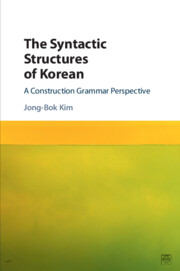Book contents
- Frontmatter
- Contents
- Acknowledgments
- Abbreviations
- 1 Theoretical foundations
- 2 Noun phrases
- 3 Case system
- 4 Auxiliary and complex predicate constructions
- 5 Gerund phrases and mixed categories
- 6 Verbal nouns and light verb constructions
- 7 Serial verb constructions
- 8 Negation and related phenomena
- 9 Coordination
- 10 Passive constructions
- 11 Wh-questions
- 12 Topic and focus constructions
- 13 Relative clause constructions
- 14 Honorification
- References
- Index
10 - Passive constructions
Published online by Cambridge University Press: 05 July 2016
- Frontmatter
- Contents
- Acknowledgments
- Abbreviations
- 1 Theoretical foundations
- 2 Noun phrases
- 3 Case system
- 4 Auxiliary and complex predicate constructions
- 5 Gerund phrases and mixed categories
- 6 Verbal nouns and light verb constructions
- 7 Serial verb constructions
- 8 Negation and related phenomena
- 9 Coordination
- 10 Passive constructions
- 11 Wh-questions
- 12 Topic and focus constructions
- 13 Relative clause constructions
- 14 Honorification
- References
- Index
Summary
Korean employs both lexical and syntactic passive constructions. The lexical passive is quite idiosyncratic in the sense that it is applicable for only a limited number of transitive verbs. Meanwhile, syntactic passive, formed with the passive auxiliary verb ci-, is productive in the sense that most of the transitive verbs have a corresponding syntactic passive. This chapter discusses key properties of the syntactic passive in Korean and then offers a construction-based HPSG analysis.
Lexical vs. syntactic passive
Korean passive constructions include both lexical and syntactic passives. Consider the following two pairs of active and passive sentences:
(1) a. Active
kyengchal-i pemin-ul cap-ass-ta
police-NOM criminal-ACC arrest-PST-DECL
‘The police arrested the criminal.’
b. Lexical passive:
pemin-i kyengchal-eykey cap-hi-ess-ta
criminal-NOM police-DAT catch-PASS-PST-DECL
‘The criminal was arrested by the police.’
(2) a. Active
ai-ka os-ul simhakey ccic-ess-ta
child-NOM clothes-ACC severely tear-PST-DECL
‘The child tore the clothes severely.’
b. Syntactic passive:
os-i simhakey ccic-e ci-ess-ta
clothes-NOM severely tear-CONN become-PST-DECL
‘The clothes were severely torn.’
In the lexical passive (1b), the addition of the passive morpheme -hi to the predicate promotes the active object into the passive subject while demoting the active subject into the passive oblique argument. Meanwhile, in the syntactic passive (2b), the promotion and demotion of the arguments are triggered by the passive auxiliary ci-ess-ta ‘become-PST-DECL’ even though there is no morphophonemic change of the main verb ccic- ‘tear’.2 That is, the form value of the main verb is intact other than the attachment of the connective marker or linker -e.
Lexical passive, realized with one of the passive morphemes, -i, -hi, -li, and -ki, is quite restricted and unproductive. For example, transitive verbs like the following cannot be lexically passivized:
(3) a. ditransitive: cwu- ‘give’, tuli- ‘give’, pachi- ‘give’, neh- ‘put’
b. benefactive: et- ‘obtain’, mantul- ‘make’, ilh- ‘lose’, top- ‘help’
c. experience: al- ‘know’, paywu- ‘learn’, pala- ‘wish’
d. symmetric: manna- ‘meet’, talm- ‘resemble’
There is also a difference even among synonymous transitive verbs. For example, the verb tam-ta ‘fill-DECL’ has its lexical passive tam-ki-ta ‘put- PASS-DECL’, but its synonymous verb neh-ta ‘put-DECL’ does not have any lexical passive.
- Type
- Chapter
- Information
- The Syntactic Structures of KoreanA Construction Grammar Perspective, pp. 226 - 241Publisher: Cambridge University PressPrint publication year: 2016

